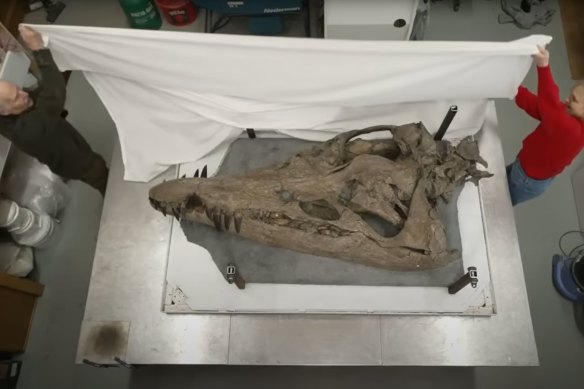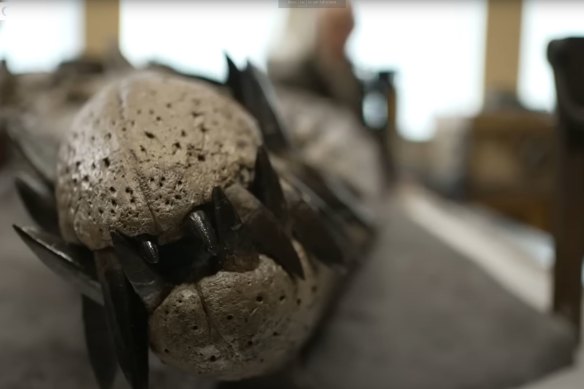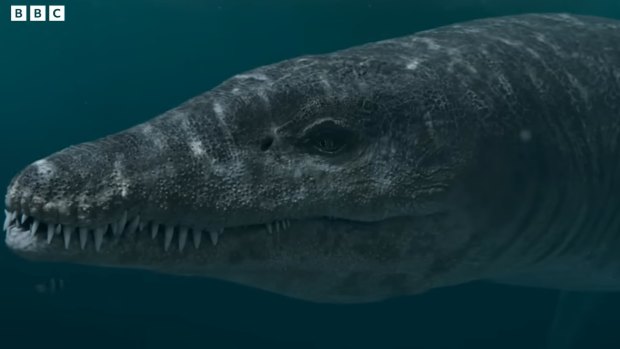By Alex Barton
London: Sir David Attenborough has unveiled a 150-million-year-old “T-Rex of the sea”, which was discovered in Dorset, England.
The marine reptile was identified as a completely new species of pliosaur and will be featured in a BBC program called Attenborough and the Giant Sea Monster to be released in the UK on New Year’s Day.
The 97-year-old will document the extraction of the giant fossilised skull. Attenborough described the pliosaur as “one of the greatest predators the world has ever seen”.

The skull of the “sea monster” found in Dorset. The rest of the fossil is believed to be buried in a seaside cliff. Credit: Screengrab/BBC
The skull is about two metres long and was embedded 15 metres down the cliff and 11 metres from the ground. Its position on the face of the cliff made it “very difficult to reach and even harder to work on”, Attenborough said.
Attenborough and the Giant Sea Monster will show the team abseiling down the cliff and drilling into the rock face, while working to stop the fossilised remains from falling into the sea below.
This pliosaur was one of the fiercest Jurassic predators that hunted in the Kimmeridgian sea during the age of the dinosaurs.
Attenborough said the rocks where the marine creature was buried were once mud on the seabed but that “over millions of years, the continents shifted, the seas receded, and today, as these cliffs erode, fossilised skeletons are revealed”.

Jaws: A close-up of the monster’s mouth.Credit: Screengrab/BBC
The fossil has survived with dozens of teeth intact with which it once hunted prey, including ichthyosaurs, a large marine reptile.
The initial discovery was made by Philip Jacobs, a textile designer who has searched for marine reptile fossils on the Jurassic coast for decades.
After finding the fossil, Jacobs contacted Steve Etches, from The Etches Collection Museum of Jurassic Marine Life, and said: “I’ve just found something quite extraordinary.“

Sir David Attenborough described it as “one of the greatest predators the world has ever seen”.Credit: Artist’s impression/Screengrab BBC
Using a drone, Jacobs and Etches located the spot on the cliff face where the fossil was and assembled a team of palaeontologists, climbers and BBC cameramen to begin the extraction process.
Etches said: “It was very exciting but, thinking logistically, not a good place to collect a fossil from. The cliffs are sheer, crumbling and unsafe, eroding quickly. It’s a very dangerous area – with large rockfalls and slippery ledges – so safety was paramount.”
The team believes the entire pliosaur may be inside the cliff, but for now are focused on the skull, which can reveal more about an animal than any other part of its skeleton.
It has survived in exceptional condition and is thought to be the best preserved and most complete of any pliosaur discovered to date.
The skull will be displayed at The Etches Collection Museum of Jurassic Marine Life after the documentary airs.
The Telegraph, London
Get a note direct from our foreign correspondents on what’s making headlines around the world. Sign up for the weekly What in the World newsletter here.